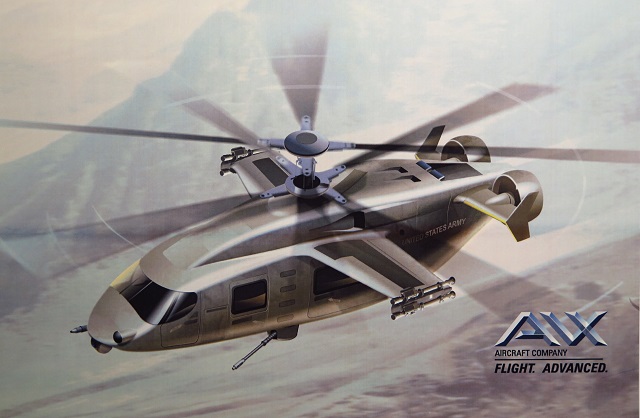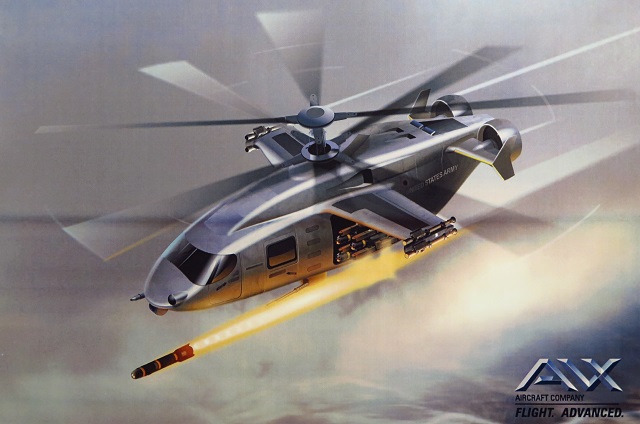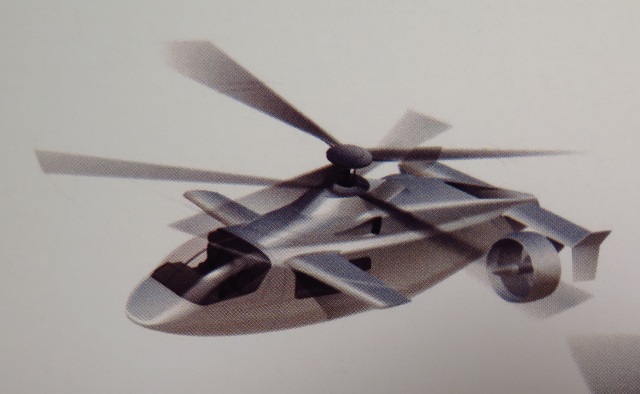AVX Aircraft of Benbrook, Texas has responded to the US Army’s request for information on the smallest of five planned Future Vertical Lift (FVL) capability sets with two 7.5t (16,700lb) winged coaxial compound helicopter configurations that the company’s chief executive describes as vertical takeoff fighter aircraft for light reconnaissance, attack, assault and medical evacuation missions.
The baseline tapered-wing, 13.4m (44ft) diametre rotor concept would be powered by two 3,000shp Improved Turbine Technology Programme (ITEP) engines and is designed to meet a demanding set of core requirements proposed by the US Army in its “Capability Set 1” RFI document. The requirements that emerged for that next-generation rotorcraft category required a more robust design than the 4.5t (10,000lb) light single that AVX discussed with the Army back in January for Capability Set 1 (CS1), prior to the 18 February RFI release.

AVX's FVL Capability Set 1 concept for assault and security operations and medical evacuation
AVX Aircraft
CS1 sought information on aircraft concepts that could achieve speeds above 200kts (370km/h) with a 229nm (424km) range. An assault/security and medical evacuation variant must accommodate six fully-loaded 151kg (335lb) troops and a gun four 360° protection.
AVX chief executive Troy Gaffey tells Flightglobal at an Army Aviation Association of America conference in Atlanta, Georgia on 29 April that the company scrabbled to complete the proposal once the RFI was released since most of its work has focused on FVL Capability Set 3, which would succeed the Sikorsky UH-60 Black Hawk and Boeing AH-64 Apache.
The company came up with two variants with 912kg (2,010lbs) internal payloads – one with a retractable missile launcher for the attack/reconnaissance mission and another that can carry the six troops and be reconfigured with two litters for medical evacuation.

AVX's FVL Capability Set 1 concept for armed reconnaissance and attack
AVX Aircraft
“I’d call it a vertical takeoff fighter airplane, because it’s intended to be flown at high speed off the deck at night,” says Gaffey. “You look at it, it’s going to have terrain avoidance radar, forward-looking infrared and all the bells and whistles with regard to weight, so the aircraft becomes large.
“It’s a fighter plane and it’s intended to fly in all weather and at night. They want an aircraft that can be reconfigured into a medivac or a troop carrier and that’s a little bit of a challenge because you’ve got to accommodate weapons, people and litters.”
The new design, which includes a tapered horizontal tail with two centreline ducted fans, is a significant departure from the Bell OH-58-based compound coaxial Kiowa Warrior concept that AVX proposed for the Army’s now-defunct Armed Aerial Scout programme. Despite cancelling AAS in 2013 and replacing the OH-58 with AH-64 Apaches teamed with unmanned aircraft, the Army remains committed to introducing a new light reconnaissance aircraft.

AVX's light single for FVL
AVX Aircraft
If the Army were to seek a lighter, less sophisticated aircraft than described in the CS1 document, AVX could propose the lighter single ITEP engine variant it has been considering. That compound coaxial design has a 12m (40ft) diametre rotor and 680kg (1,500lb) payload.
Sikorsky has been touting its S-97 Raider, which has rigid counter-rotating blades and a pusher prop, for that mission as well as Capability Set 1. Bell Helicopter has been exploring a tiltrotor solution.
Source: FlightGlobal.com
















